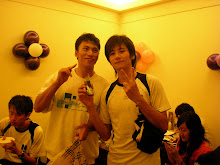Makovski, T., & Jiang, Y. V. (2008). Proactive interference from items previously stored in visual working memory. Memory & Cognition, 36, 43-52.
Abstract:
This study investigates the fate of information that was previously stored in visual working memory but that is no longer needed. Previous research has found inconsistent results, with some showing effective release of irrelevant information and others showing proactive interference. Using change detection tasks of colors or shapes, we show that participants tend to falsely classify a changed item as "no change" if it matches one of the memory items on the preceding trial. The interference is spatially specific: Memory for the preceding trial interferes more if it matches the feature value and the location of a test item than if it does not. Interference results from retaining information in visual working memory, since it is absent when items on the preceding trials are passively viewed, or are attended but not memorized. We conclude that people cannot fully eliminate unwanted visual information from current working memory tasks.
Note:
This paper addressed the issue whether previously attended and memorized items could influence the visual memory of the subsequent item (so-called proactive inference). If there is a proactive inference, the memory performance in the n trial will be affected by the item presented in the n-1 trial.
Exp 1 showed that memory performance of color item in the n trial decreased when the probe’s color matched that of the n-1’s item at the same location (spatial specificity). Exp 2 generated the effect to the shape feature. Also, the proactive interference was only found when the item in the n-1 trials was actively attended and memorized. Results also suggested that the VSTM is configuration-based. A very clever method used in Experiment 3 showed that both spatial and temporal interference contributed to the interference effect. 4AFC memory test in which the choices included: correct answer (true color), novel color, the color in n-1 trial at the probe location (temporal interference), and the color item adjacent to the probe (spatial interference) was used. It is suggested that the VWM is temporally and spatially imprecise.
This blog is about my research and what I am interested in. I will keep updating new information. Hope all of you enjoy it.
Labels
訂閱:
張貼留言 (Atom)
About Me

- Yang Cheng-Ta (楊政達)
- I am Yang Cheng-Ta. I am a assistant professor at the department of psychology and institute of cognitive science, National Cheng Kung University (NCKU). I graduated from National Taiwan University (NTU). My supervisors were Prof. Yeh Yei-Yu and Prof. Hsu Yung-Fong. My major is cognitive psychology and mathematical psychology. My research interests are human attention and memory. My research topic is about why people cannot detect a change in the visual environment which is so-called “change Blindness”. I investigate the mechanism underlying change detection and how people make a correct detection decision. I am also interested in the mathematical modeling of human behavior. Besides, I like to play volleyball, go to gym, and swim when I am free. I also like to listen to the Chinese opera and still keep learning it. These are brief descriptions about me. If you are interested in me or share interests with me, contact with me at yangct@mail.ncku.edu.tw.
My Web
Personal Information
Conference
- 2010.3.7.-3.12. annual meeting of visual science society ()2009.12.1.截止)
- 台灣心理學會第48屆年會,9.26.-9.27.台大開會。投稿時間即將於7月31日截止。
- The 50th Annual Meeting of psychonomic society at Boston 2009.11.19.-11.22. (6月1日前截止投稿)
- 2009.6.24.-6.25. workshop of attention and perception (5.27.前截止投稿)
- 2009.8.1.-8.4. conference of Math Psych (4.31.截止)
- Annual meeting of visual science society May 8-13, 2009 (12.2.截止投稿)
- 第47屆台灣心理學年會 師大 (7.31截止)
- 13th workshop of attention and perception(嘉義中正大學)
- OPAM November, 13th, 2008, Chicago, Illinois ( 7月1日截止)
- 49th ANNUAL MEETING OF THE PSYCHONOMIC SOCIETY, Chicago Hilton Hotel, Chicago, Illinois, Thursday, November 13 – Sunday, November 16, 2008 (6月2日截止)
- NathPsych (四月一日截止)
- 華人心理學會註冊
- 2008.6.11-14 第六屆華人心理學家學術研討會 (一月底截止)
Shared Resources
- 用endnote寫論文
- working memory guides attention的討論文章
- E-Prime範例八:reaction time and accuracy
- E-Prime 範例七:feature integration theory
- E-Prime範例六:staircase 直接用程式顯現螢幕顏色
- signal detetcion theory
- OL釘書機
- E-Prime範例五:改變偵測(隨機指定位置與顏色)
- E-Prime範例四:stair case(二下一上)
- E-Prime範例三:false memory
- 神奇撲克牌變色魔術
- E-Prime範例二:primary memory
- E-Prime範例一:depth of processing
- Youtube 整理change blindness的範例
- E-Prime User's Guide
- E-Prime Introduction
- E-Prime data analysis
- E-Prime 中文使用說明 (「林思宏」改版,第一版由「黃卓寧」(2005.9.)撰寫)
Useful Links
- slideshare
- Associations for Psychological Science
- Visual Science Society
- 行政院國科會
- Psychonomic Society
- American Psychological Association
- Society for Mathmatical Psychology
- Yahoo MathPsych student
- National Taiwan University
- Department of Psychology, National Taiwan University
- ScienceDirect
- Taylor & Francis
- IngentaConnect
Online Resources
- Lee's homepage introduciton to matbugs
- hint of writing winbugs
- Matbugs: use matlab to interface with winbugs
- how to use winbugs and related issues (by 林永雋)
- Bayes data analysis
- 2008 科學季 眼界奇觀 (我與大學部小朋友共同製作)
- Hierarchical Signal Detection Model (Jeff's lab)
- labmeeting
- American Journal Experts
- ERRNET
- A theory of visaul attention
- STATSOFT
- E-Prime
- E-prime tutorial
- R
- Pubmed
- MatLab Codes
- Google Scholar
- Semantic association calculation
- Neuroimaging Resource
- Association Norm
沒有留言:
張貼留言